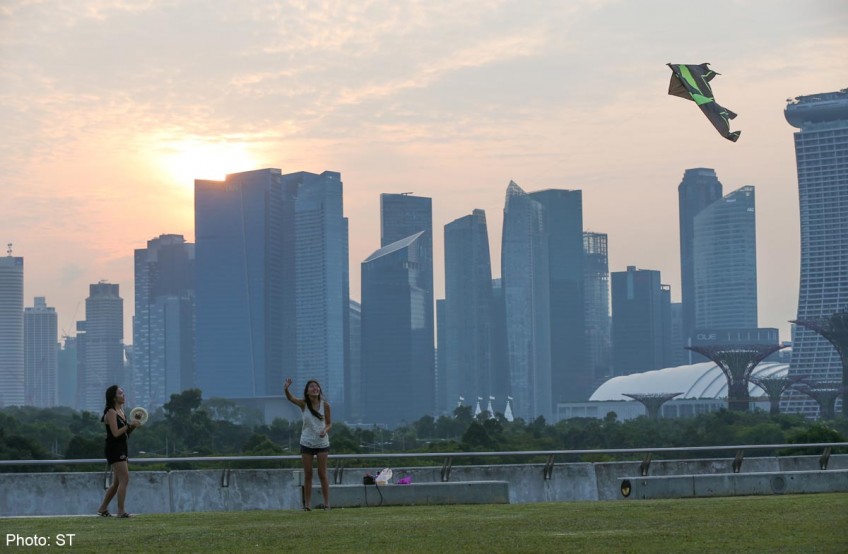Haze eases after hitting unhealthy level

WORK, school and exercise. People here were back to their usual routines as the air quality improved yesterday.
At 7pm, the three-hour Pollutant Standards Index (PSI), which measures air quality here, was a moderate 75. The National Environment Agency (NEA) said in its daily haze advisory yesterday that the improved condition was due to "a change in the prevailing wind direction, blowing from the south-east".
Prevailing winds today are also forecast to be from the south or south-east, it noted. Showers in the late morning and early afternoon are expected. The overall air quality should be mainly in the high end of the moderate range, but may move into the low end of the unhealthy range should the winds turn unfavourable.
Singaporeans were forced indoors on Monday night, with some forgoing their night jogs when the three-hour PSI climbed to the unhealthy level of 153 at 7pm - the highest recorded this year. Air quality remained in the unhealthy range till 4am yesterday.
The air was noticeably clearer by the time people left their homes for work and school yesterday morning.
Tax assistant Rebecca Chan, 24, said: "I will think twice about exercising outdoors but, other than that, I will proceed with my daily activities since the exposure is short."
Staying totally indoors would be a consideration only if the PSI hit 300 and beyond, said branding executive Marcus Yong, 27.
Singapore has experienced occasional bouts of haze over the last month following Sept 15, when the PSI level crossed into the unhealthy range for the first time since April. At such levels, prolonged or strenuous outdoor physical exertion should be reduced or avoided. Normal activities can carry on at PSI readings of 100 and below.
The change in Monday's air quality was unexpected, noted some people, with PSI readings creeping from moderate to unhealthy levels within a few hours.
Experts attributed this to a few factors, such as the location, size and number of hot spots as well as wind speed and direction.
One main reason, said Assistant Professor Winston Chow of the National University of Singapore's (NUS) geography department, was a change in surface wind direction. He said: "Any consistent surface wind from the south-west would likely bring the smoke haze over to Singapore, as was seen for most of Monday."
Assistant Professor Jason Cohen of NUS' department of civil and environmental engineering also noted that the harmful PM2.5 air pollutant - tiny particles smaller than 2.5 microns in diameter - "will move with the wind in whatever direction the wind travels".
While it was business as usual for most people yesterday, some took precautions, such as keeping an N95 mask handy. Housewife Karen Koh, 48, said she turned on the air-conditioning and started using air purifiers at home.
Monday's bad air did not spark a rush for face masks or air purifiers like it did in June last year, when the three-hour PSI reading hit the hazardous level of 401, but retailers contacted said interest in such products remained high.
Purchasing manager Kelsy Lim of Gain City said - without providing exact sales figures - that there had been three times more inquiries and purchases for air purifiers, compared with a typical weekend.
At e-commerce portal Qoo10 Singapore, there were five times more orders for air purifiers last month, compared to the hundreds sold in a regular month, said its public relations head James Lin.
audreyt@sph.com.sg
samboh@sph.com.sg
What to do when the haze hits
THE health impact of the haze depends on more than the concentration levels of pollutants in the air.
How long a person is exposed, how intensive his activity as well as his state of health should also be considered, the National Environment Agency (NEA) said in its daily haze advisory yesterday.
Health advisories issued by the authorities in Singapore are based on the 24-hour Pollutant Standards Index (PSI), a measure of air quality, as studies on the health effects of particulate matter have been based on this duration of exposure.
24-hour PSI: 100 and below (Good/moderate)
- Normal activities can be carried out.
24-hour PSI: 101 to 200 (Unhealthy)
- Healthy people should reduce prolonged or strenuous outdoor physical exertion.
- Elderly people, pregnant women and children should minimise such exertion.
- Those with chronic lung or heart diseases should avoid such activities completely.
24-hour PSI: 201 to 300 (Very unhealthy)
- Healthy people should avoid prolonged or strenuous outdoor physical exertion.
- Elderly people, pregnant women and children should minimise all outdoor activity.
- Those with chronic lung or heart diseases should avoid going outdoors altogether.
24-hour PSI: Above 300 (Hazardous) LHealthy people should minimise outdoor activity.
- Those who are more vulnerable should not go outdoors.

Get a copy of The Straits Times or go to straitstimes.com for more stories.